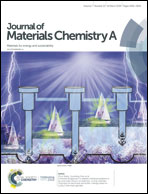A novel dried plum-like yolk–shell architecture of tin oxide nanodots embedded into a carbon matrix: ultra-fast assembly and superior lithium storage properties†
Abstract
Tin oxides as some of the potential candidates for commercial graphite anodes suffer from serious drawbacks such as poor electronic conductivity and large volume variation during cycling. Dispersing nanostructured SnOx into a carbon matrix may be an effective strategy to solve these problems. In this work, a novel dried plum-like yolk–shell SnOx/C architecture with high specific surface area and superior structural stability is constructed by an extremely facile and scalable spray pyrolysis method in ten seconds. The SnOx nanodots (<10 nm) are uniformly embedded into the in situ generated carbon matrix. Polyvinylpyrrolidone is introduced here as a multifunctional agent to generate the dried plum-like yolk–shell morphology as well as to form the carbon matrix. The formation mechanism of such a unique morphology is discussed and revealed with in-depth comparison. As an anode for lithium ion batteries, the characteristic SnOx/C yolk–shell microspheres exhibit a high reversible capacity of 1142 mA h g−1 at 0.2 A g−1, good rate capability of 509 mA h g−1 at 5 A g−1, and excellent cycling performance of ∼100% capacity retention in 600 cycles. This work provides an ultra-simple route for large scale production of yolk–shell nanomaterials for energy-related as well as other applications.



 Please wait while we load your content...
Please wait while we load your content...